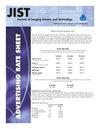Passive Haptic Learning of Taiwanese Braille Writing for Visually Impaired Individuals
IF 0.5
4区 计算机科学
Q4 IMAGING SCIENCE & PHOTOGRAPHIC TECHNOLOGY
Journal of Imaging Science and Technology
Pub Date : 2021-03-01
DOI:10.2352/j.imagingsci.technol.2021.65.2.020402
引用次数: 0
Abstract
Abstract In this article, a passive haptic learning method for Taiwanese Braille writing was developed for visually impaired individuals through the employment of an effective user-friendly learning strategy. This system was designed with portability and low cost by applying the learning concept of passive haptic learning. This system designed a pair of gloves for visually impaired people to study Braille writing. Furthermore, we also designed a Braille writing teaching system for visually impaired people to learn and practice the Braille writing. Depending on the learning content, the corresponding vibration motors on the glove fingertips vibrate to produce the Taiwan Braille input gestures. The visually impaired people then feel tactile vibration feedback from the glove fingertips. In addition, the corresponding auditory feedback is provided from the Braille writing teaching system. After receiving a series of tactile vibration feedback, user’s finger muscles could memorize the corresponding Braille input gestures by the passive haptic learning. In the practice mode, the teaching system randomly selects practice content and announces the selected content in an auditory manner. Visually impaired users must then input the corresponding Braille codes by using the Braille writing input module. This mode can further reinforce users’ memorization of correct Braille codes for Mandarin characters.视障人士台湾盲文书写的被动触觉学习
摘要在本文中,通过采用一种有效的用户友好学习策略,为视障人士开发了一种用于台湾盲文写作的被动触觉学习方法。该系统采用了被动触觉学习的学习概念,具有便携性和低成本的特点。该系统为视障人士设计了一副学习盲文书写的手套。此外,我们还设计了一个盲文写作教学系统,供视障人士学习和练习盲文写作。根据学习内容,手套指尖上相应的振动电机振动,产生台湾盲文输入手势。视力受损的人然后感觉到来自手套指尖的触觉振动反馈。此外,盲文写作教学系统还提供了相应的听觉反馈。在接收到一系列触觉振动反馈后,用户的手指肌肉可以通过被动触觉学习来记忆相应的盲文输入手势。在实践模式中,教学系统随机选择实践内容,并以听觉的方式宣布所选内容。视障用户必须使用盲文书写输入模块输入相应的盲文代码。这种模式可以进一步加强用户对普通话盲文正确代码的记忆。
本文章由计算机程序翻译,如有差异,请以英文原文为准。
求助全文
约1分钟内获得全文
求助全文
来源期刊

Journal of Imaging Science and Technology
工程技术-成像科学与照相技术
CiteScore
2.00
自引率
10.00%
发文量
45
审稿时长
>12 weeks
期刊介绍:
Typical issues include research papers and/or comprehensive reviews from a variety of topical areas. In the spirit of fostering constructive scientific dialog, the Journal accepts Letters to the Editor commenting on previously published articles. Periodically the Journal features a Special Section containing a group of related— usually invited—papers introduced by a Guest Editor. Imaging research topics that have coverage in JIST include:
Digital fabrication and biofabrication;
Digital printing technologies;
3D imaging: capture, display, and print;
Augmented and virtual reality systems;
Mobile imaging;
Computational and digital photography;
Machine vision and learning;
Data visualization and analysis;
Image and video quality evaluation;
Color image science;
Image archiving, permanence, and security;
Imaging applications including astronomy, medicine, sports, and autonomous vehicles.
 求助内容:
求助内容: 应助结果提醒方式:
应助结果提醒方式:


